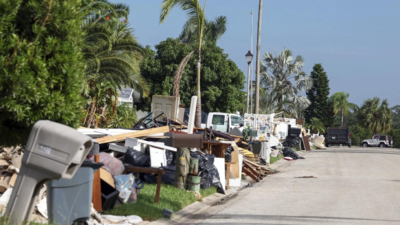
As Hurricane Milton barrels toward
Florida
's Gulf Coast, the storm has triggered mass
evacuations
, fuel shortages, and traffic jams across the state. The
Category 5
hurricane, one of the strongest Atlantic storms on record, is expected to make landfall late Wednesday or early Thursday. With over a million people ordered to flee, officials have issued urgent warnings, describing the storm as a potentially "catastrophic" event, especially for the
Tampa Bay
area.
The storm comes just 12 days after Hurricane Helene devastated parts of the state, further exacerbating Florida's vulnerability to Milton’s destruction. Florida Governor Ron DeSantis and President Joe Biden have both urged residents in evacuation zones to leave immediately, warning that this could be a life-or-death situation.
1. Mass evacuations ordered for over 1 million people
Officials have mandated the evacuation of over a million people living along Florida’s west coast. The hardest-hit areas are expected to be Tampa Bay and surrounding counties, with residents fleeing ahead of Hurricane Milton's anticipated landfall.
2. Traffic jams and fuel shortages create chaos
Long lines at gas stations and bumper-to-bumper traffic clogged Florida’s roads as residents scrambled to evacuate. According to GasBuddy, around 17% of the state’s gas stations ran out of fuel by Tuesday evening, with some areas experiencing nearly 43% fuel shortages.
3. Hurricane Milton reaches Category 5 strength again
After briefly weakening, Hurricane Milton regained Category 5 status, with sustained winds of 165 mph. The National Hurricane Center warned that the storm could cause widespread destruction, including a life-threatening
storm surge
.
4. Unusual path and rapid intensification raise alarm
Meteorologists are concerned about Milton’s rapid intensification and unusual path, making its potential impact difficult to predict. The Tampa Bay area hasn’t seen a direct hurricane hit since 1921, increasing worries about the storm’s devastating potential.
5. Storm surge threatens to swallow coastal areas
Forecasters predict storm surges of 10 to 15 feet along Florida's coastline, threatening to inundate hundreds of miles of beachfront property. Such surges could level buildings, destroy infrastructure, and endanger lives, particularly in low-lying areas.
6. President Biden urges immediate evacuation
President Joe Biden postponed international travel to oversee the federal response to Milton, urging Floridians to heed evacuation orders. "It's a matter of life and death," he warned, stressing that staying behind in evacuation zones could be fatal.
7. National Guard deployed to aid evacuation and response
More than 5,000 members of the Florida National Guard have been deployed, with an additional 3,000 on standby to assist in the aftermath of the storm. These troops will help in search-and-rescue missions and provide essential services in affected areas.
8. Economic impact expected to be severe
Hurricane Milton threatens to disrupt major industries across Florida. Approximately 2.8% of the U.S. gross domestic product is in the storm's direct path, with airlines, energy firms, and theme parks already halting operations in preparation for the hurricane’s landfall.
9. Tampa officials issue dire warnings
Tampa Mayor Jane Castor urged residents not to underestimate the storm, recalling the devastation caused by Hurricane Helene just two weeks ago. “If you choose to stay in one of those evacuation areas, you’re going to die,” Castor warned, underscoring the gravity of the situation.
10. Helene’s aftermath leaves Florida vulnerable
Florida’s west coast is still reeling from Hurricane Helene’s impact, which eroded beaches, destroyed dunes, and left infrastructure weakened. The aftermath of Helene has left the state particularly vulnerable to the destruction Milton is expected to bring.
(With inputs from agencies)

 1 month ago
7
1 month ago
7










 English (US) ·
English (US) ·